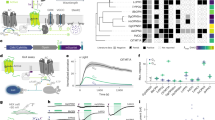Abstract
THE sum of all synaptic currents flowing at any moment through the motoneurone membrane represents the synthesis of the commands converging on to the final common path. Transduction of such commands into muscle contraction is accomplished by the conversion of current into motoneuronal firing and, in turn, conversion of the nervous discharge into mechanical events1. Thus, the motor unit, that is, each motoneurone with the muscle fibres it innervates, operates as the interface between the central nervous system and the environment. The motor unit response to steady inputs is well known. Constant currents are transformed into constant-rate discharges, whose frequencies are proportional, over a definite range, to the current intensities2; in isometric conditions, such constant-rate discharges build up steady and proportional levels of muscle tension3–5. On the other hand, little is known about the motor unit response to dynamic inputs. Recent work5, however, has suggested that the rate of growth of the current stimulating the motoneurone may be converted into a proportional rate of development of the muscle tension. In view of this last hypothesis, we have analysed the isometric tension developed by single motor units when motoneurones were stimulated with current pulses of trapezoidal shape, that is, reaching a given steady level after rectilineal (ramp) growth of different slopes. This approach was adopted on the assumption that current injected by an intracellular electrode into a motoneurone is physically equivalent of total synaptic current acting on the cell1,2.
This is a preview of subscription content, access via your institution
Access options
Subscribe to this journal
Receive 51 print issues and online access
$199.00 per year
only $3.90 per issue
Buy this article
- Purchase on Springer Link
- Instant access to full article PDF
Prices may be subject to local taxes which are calculated during checkout
Similar content being viewed by others
References
Granit, R. in The Basis of Motor Control (Academic, London and New York 1970).
Granit, R., Kernell, D. & Shortess, G. K. J. Physiol., Lond. 168, 911–931 (1963).
Cooper, S. & Eccles, J. C. J. Physiol., Lond. 69, 377–385.(1930).
Kernell, D. in Muscular Afferents and Motor Control–Nobel Symposium (ed. Granit, R.) 351–362 (Almquist & Wiksell, Stockholm, 1966).
Baldissera, F. & Parmiggiani, F. Brain Res. 91, 315–320 (1975).
Burke, R. E. J. Physiol., Lond. 193, 141–160 (1967).
Baldissera, F. & Gustafsson, B. Brain Res. 30, 431–434 (1971).
Kernell, D. Brain Res. 41, 184–186 (1972).
Baldissera, F. & Gustafsson, B. Acta physiol. scand. 91, 528–544 (1974).
Baldissera, F. & Gustafsson, B. Acta physiol. scand. 92, 27–47 (1974).
Mauritz, K. H., Schlue, W. R., Richter, D. W. & Nacimiento, A. C. Brain Res. 76, 223–233 (1974).
Mishelevic, D. J. Expl Neurol. 25, 401–409 (1969).
Kernell, D. & Sjoholm, H. Acta physiol. scand. 87, 40–56 (1973).
Baldissera, F., Gustafsson, B. & Parmiggiani, F. Biol. Cybernetics 24, 61–66 (1976).
Burke, R. E., Rudomin, P. & Zajac, F. E., Brain Res. 109, 515–529 (1976).
Colomo, F., Urbani, F. & Ciocia, G. Arch. Fisiol. 68, 134–148 (1970–71).
Author information
Authors and Affiliations
Rights and permissions
About this article
Cite this article
BALDISSERA, F., CAMPADELLI, P. How motoneurones control development of muscle tension. Nature 268, 146–147 (1977). https://doi.org/10.1038/268146a0
Received:
Accepted:
Issue Date:
DOI: https://doi.org/10.1038/268146a0
This article is cited by
-
Doublet of action potentials evoked by intracellular injection of rectangular depolarization current into rat motoneurones
Experimental Brain Research (2010)
-
After hyperpolarization conductance time-course and repetitive firing in a motoneurone model with early inactivation of the slow potassium conductance system
Biological Cybernetics (1979)
Comments
By submitting a comment you agree to abide by our Terms and Community Guidelines. If you find something abusive or that does not comply with our terms or guidelines please flag it as inappropriate.



